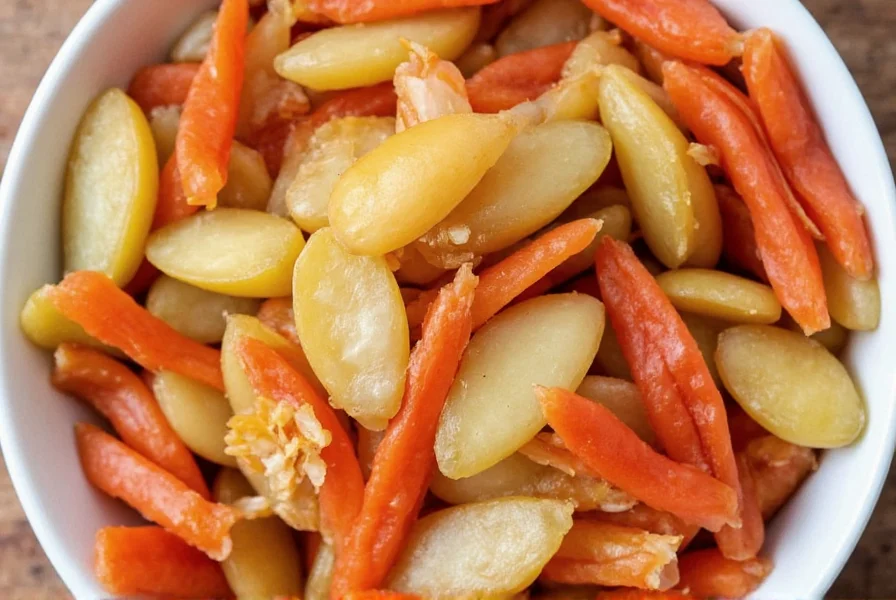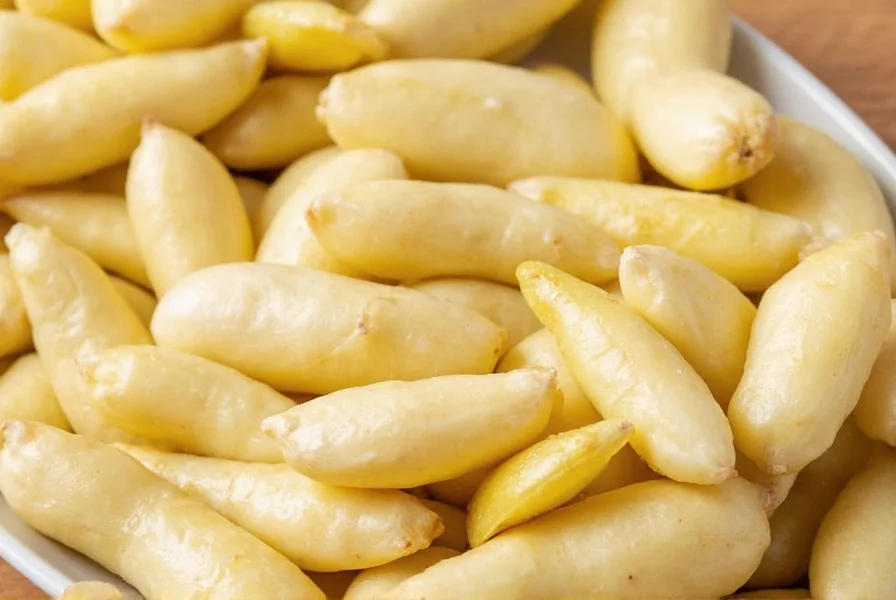Pickled ginger represents one of the most distinctive elements of traditional Japanese dining culture, particularly within sushi preparation. This vibrant condiment transforms raw ginger's sharp heat into a nuanced accompaniment that complements delicate fish flavors while serving practical culinary functions. Understanding its proper preparation, varieties, and applications elevates both home cooking and dining experiences.
Understanding the Two Main Types of Pickled Ginger
Many people don't realize there are two distinct varieties of pickled ginger commonly used in Japanese cuisine, each serving different culinary purposes:
| Type | Characteristics | Primary Use |
|---|---|---|
| Gari | Thinly sliced young ginger, pale pink color, mild sweet-sour flavor | Served with sushi to cleanse palate between different fish types |
| Beni Shoga | Thinly shredded mature ginger, bright red color, stronger vinegar taste | Used as topping for dishes like yakisoba, okonomiyaki, and gyudon |
The confusion between these varieties explains why many homemade attempts at traditional sushi ginger miss the mark. Authentic gari requires young spring ginger, which contains natural enzymes that interact with vinegar to create its characteristic pale pink color without artificial dyes.
Traditional Preparation Methods and Ingredients
Creating authentic pickled ginger at home requires attention to specific ingredients and timing. The traditional Japanese method emphasizes simplicity and natural processes:
- Ginger selection: Young spring ginger (shin shoga) with thin skin and high moisture content
- Vinegar base: Rice vinegar provides the proper mild acidity
- Sweetener: Sugar balance is critical—typically a 2:1 vinegar-to-sugar ratio
- Preparation technique: Slicing ginger paper-thin (about 1mm) before pickling
Many Western recipes mistakenly use mature ginger or add artificial coloring, resulting in a product that lacks the delicate flavor profile of authentic gari. The natural pink hue develops through a chemical reaction between the ginger's anthocyanins and the vinegar's acidity over several days of marination.

Culinary Applications Beyond Sushi
While most associate pickled ginger with sushi restaurants, its culinary applications extend far beyond traditional Japanese dining. Understanding how to incorporate this versatile condiment can transform everyday meals:
- Palate cleanser: Serve small portions between courses of rich or fatty foods
- Salad enhancement: Adds bright acidity to green salads and grain bowls
- Seafood pairing: Complements grilled or raw fish dishes beyond sushi
- Cooking ingredient: Finely minced in dressings, marinades, or stir-fry sauces
Professional chefs often keep homemade pickled ginger on hand as a flavor balancing tool. Its combination of acidity, subtle sweetness, and ginger's natural warmth makes it particularly effective at cutting through rich or oily dishes while adding complexity without overwhelming other flavors.
Evidence-Based Health Benefits
Pickled ginger retains many of fresh ginger's beneficial compounds while becoming more digestible through the pickling process. Research supports several health benefits associated with regular consumption:
- Digestive support: Gingerol content stimulates digestive enzymes and reduces nausea
- Antioxidant properties: Contains compounds that combat oxidative stress
- Anti-inflammatory effects: May help reduce inflammation markers in the body
- Oral health: Natural antibacterial properties help cleanse the palate
Unlike raw ginger, the pickling process makes these compounds more bioavailable while reducing the intense heat that some find overwhelming. The vinegar base also contributes probiotic benefits through fermentation, though traditional quick-pickled gari contains fewer live cultures than fermented varieties.
Storage Guidelines and Shelf Life
Proper storage significantly impacts both the quality and safety of homemade pickled ginger. Understanding these storage parameters ensures optimal flavor and safety:
- Refrigeration: Always store in airtight container in refrigerator (33-40°F/1-4°C)
- Shelf life: Properly prepared pickled ginger lasts 3-6 months refrigerated
- Quality indicators: Discard if texture becomes mushy or develops off odors
- Freezing option: Can be frozen for up to 1 year with minimal quality loss
Commercial products often contain preservatives that extend shelf life, but homemade versions rely on proper acidification for safety. The vinegar-to-water ratio must maintain pH below 4.6 to prevent bacterial growth. When making homemade pickled ginger, always use food-safe containers and sterilized equipment to ensure safety.
Creating Perfect Homemade Pickled Ginger
Many home cooks struggle with achieving restaurant-quality pickled ginger. The following professional technique yields authentic results:
- Peel 8 ounces of young ginger and slice paper-thin using a mandoline
- Soak slices in ice water for 30 minutes to enhance crispness
- Drain and pack ginger into sterilized glass jar
- Heat 1 cup rice vinegar and ½ cup sugar until dissolved (do not boil)
- Pour hot brine over ginger, ensuring complete submersion
- Cool to room temperature, then refrigerate for 3-5 days before use
The waiting period allows flavors to develop fully and the natural pink color to emerge. Rushing this process results in inferior texture and flavor. For best results, use the pickled ginger within 2-3 months of preparation.
What's the difference between gari and regular pickled ginger?
Gari specifically refers to the thin-sliced, mildly sweet pickled ginger served with sushi, made from young ginger with a pale pink color. Regular pickled ginger often uses mature ginger, has stronger vinegar flavor, and may be artificially colored red (as in beni shoga). Gari's delicate flavor profile makes it suitable for palate cleansing between sushi pieces.
Why is my homemade pickled ginger not turning pink?
The natural pink color develops from anthocyanins in young spring ginger reacting with vinegar's acidity. If using mature ginger (which lacks sufficient anthocyanins) or if the vinegar pH is too high, the pink hue won't develop. Authentic gari achieves its color naturally over 3-5 days of marination—avoid artificial coloring for traditional preparation.
Can I use pickled ginger for medicinal purposes?
While pickled ginger retains some of fresh ginger's beneficial compounds like gingerol, the pickling process reduces enzyme activity. It can help with mild digestive issues and nausea, but shouldn't replace medical treatment for serious conditions. The vinegar content makes it gentler on the stomach than raw ginger while still providing some anti-nausea benefits.
How long does it take for homemade pickled ginger to be ready?
Authentic pickled ginger requires patience—while technically edible after 24 hours, the flavor profile fully develops after 3-5 days of refrigeration. The ginger's natural enzymes need this time to interact with the vinegar, creating the characteristic subtle sweetness and delicate pink color. Rushing the process results in inferior texture and flavor balance.
Does pickled ginger lose nutritional value during pickling?
The pickling process preserves many beneficial compounds while making them more bioavailable. While some heat-sensitive vitamins decrease, ginger's key active compounds (gingerols) remain stable in vinegar solutions. The fermentation process may even create additional beneficial compounds. Properly prepared pickled ginger maintains significant antioxidant and anti-inflammatory properties compared to raw ginger.











 浙公网安备
33010002000092号
浙公网安备
33010002000092号 浙B2-20120091-4
浙B2-20120091-4